初高中英语知识点衔接
- 格式:docx
- 大小:121.22 KB
- 文档页数:96
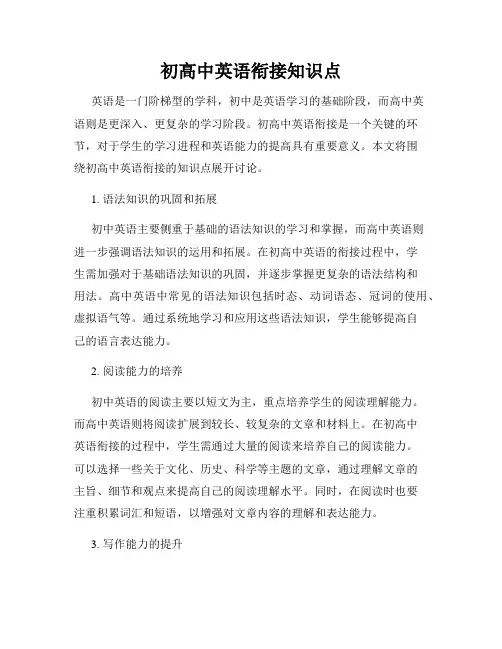
初高中英语衔接知识点英语是一门阶梯型的学科,初中是英语学习的基础阶段,而高中英语则是更深入、更复杂的学习阶段。
初高中英语衔接是一个关键的环节,对于学生的学习进程和英语能力的提高具有重要意义。
本文将围绕初高中英语衔接的知识点展开讨论。
1. 语法知识的巩固和拓展初中英语主要侧重于基础的语法知识的学习和掌握,而高中英语则进一步强调语法知识的运用和拓展。
在初高中英语的衔接过程中,学生需加强对于基础语法知识的巩固,并逐步掌握更复杂的语法结构和用法。
高中英语中常见的语法知识包括时态、动词语态、冠词的使用、虚拟语气等。
通过系统地学习和应用这些语法知识,学生能够提高自己的语言表达能力。
2. 阅读能力的培养初中英语的阅读主要以短文为主,重点培养学生的阅读理解能力。
而高中英语则将阅读扩展到较长、较复杂的文章和材料上。
在初高中英语衔接的过程中,学生需通过大量的阅读来培养自己的阅读能力。
可以选择一些关于文化、历史、科学等主题的文章,通过理解文章的主旨、细节和观点来提高自己的阅读理解水平。
同时,在阅读时也要注重积累词汇和短语,以增强对文章内容的理解和表达能力。
3. 写作能力的提升初中英语的写作主要以句子和短文的书写为主,侧重于表达语法准确、逻辑清晰的观点。
而高中英语则要求学生在写作中更加注重词汇的丰富和句子结构的多样化。
在初高中英语衔接的过程中,学生需通过多样化的写作练习来提升自己的写作能力。
可以从写日记、写作文、写小说等方面入手,尝试使用更多的词汇和句型,以及提高语言的流畅度和表达的准确性。
4. 口语表达能力的培养初中英语的口语主要以课堂上的问答和简单对话为主,侧重于培养学生的口头表达能力。
而高中英语则要求学生在口语交流中更加注重用词的准确性和语法的正确性。
在初高中英语衔接的过程中,学生应该通过参加英语角、口语比赛等活动来提升自己的口语表达能力。
可以选择一些话题,与同学或外教进行口语练习,锻炼自己的听、说能力。
5. 课外拓展学习除了课堂上的学习,学生还可以通过其他途径进行课外拓展学习。
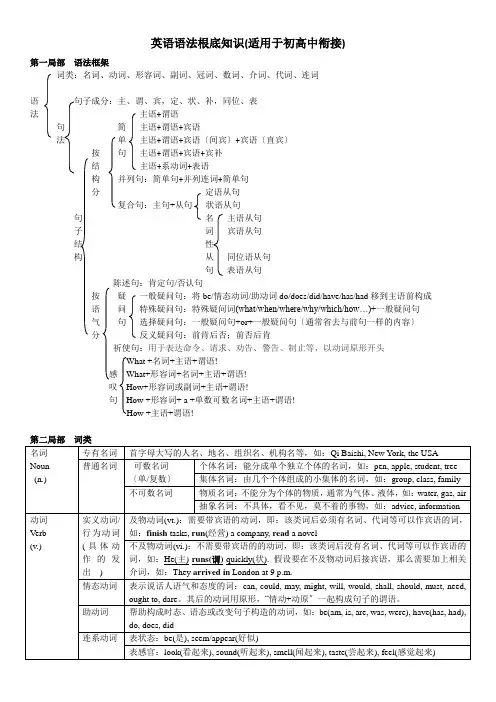
英语语法根底知识(适用于初高中衔接)第一局部语法框架词类:名词、动词、形容词、副词、冠词、数词、介词、代词、连词语句子成分:主、谓、宾,定、状、补,同位、表法主语+谓语句简主语+谓语+宾语法单主语+谓语+宾语〔间宾〕+宾语〔直宾〕按句主语+谓语+宾语+宾补结主语+系动词+表语构并列句:简单句+并列连词+简单句分定语从句复合句:主句+从句状语从句句名主语从句子词宾语从句结性构从同位语从句句表语从句陈述句:肯定句/否认句按疑一般疑问句:将be/情态动词/助动词do/does/did/have/has/had移到主语前构成语问特殊疑问句:特殊疑问词(what/when/where/why/which/how…)+一般疑问句气句选择疑问句:一般疑问句+or+一般疑问句〔通常省去与前句一样的内容〕分反义疑问句:前肯后否;前否后肯祈使句:用于表达命令、请求、劝告、警告、制止等,以动词原形开头What +名词+主语+谓语!感What+形容词+名词+主语+谓语!叹How+形容词或副词+主语+谓语!句How +形容词+ a +单数可数名词+主语+谓语!How +主语+谓语!第三局部句子成分及简单句一、简单句的五大根本句型:主语+ 谓语名词/代词/动名词/不定式+ 不及物动词主语+ 谓语+ 宾语名词/代词/动名词/不定式+ 及物动词+ 名词/代词/动名词/不定式主语+ 谓语+ 宾语〔间宾〕+ 宾语〔直宾〕名词/代词/动名词/不定式+ 及物动词+ 代词+ 名词主语+ 谓语+ 宾语+ 宾补名词/代词/动名词/不定式+ 及物动词+ 代词+ 代词/名词/数词/非谓语动词/副词/形容词/介词短语主语+ 系动词+ 表语名词/代词/动名词/不定式+ 系动词+ 代词+ 代词/名词/数词/非谓语动词/副词/形容词/介词短语实例依次如下:She arrived (on time). 主谓(状)她按时到了。
We will accept (their) invitation. 主谓(定)宾我们将承受他们的邀请。
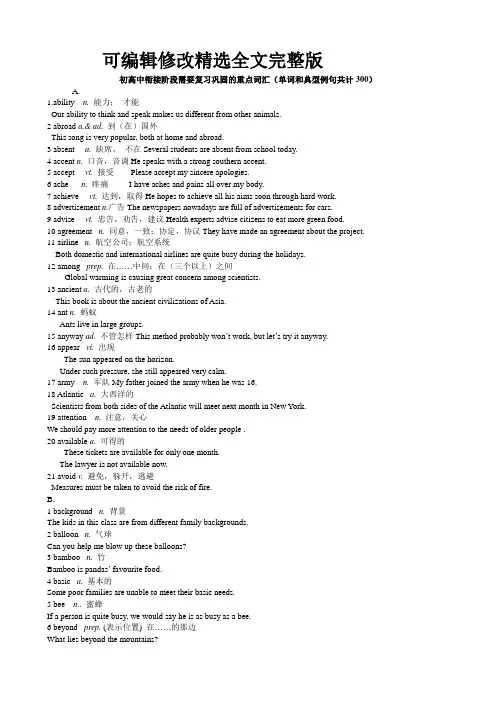
可编辑修改精选全文完整版初高中衔接阶段需要复习巩固的重点词汇(单词和典型例句共计300)A.1.ability n.能力;才能Our ability to think and speak makes us different from other animals.2 abroad a.& ad.到(在)国外This song is very popular, both at home and abroad.3 absent a.缺席,不在Several students are absent from school today.4 accent n.口音,音调He speaks with a strong southern accent.5 accept vt.接受Please accept my sincere apologies.6 ache n.疼痛I have aches and pains all over my body.7 achieve vt.达到,取得He hopes to achieve all his aims soon through hard work.8 advertisement n.广告The newspapers nowadays are full of advertisements for cars.9 advise vt.忠告,劝告,建议Health experts advise citizens to eat more green food.10 agreement n.同意,一致;协定,协议They have made an agreement about the project.11 airline n.航空公司;航空系统Both domestic and international airlines are quite busy during the holidays.12 among prep.在……中间;在(三个以上)之间Global warming is causing great concern among scientists.13 ancient a.古代的,古老的This book is about the ancient civilizations of Asia.14 ant n.蚂蚁Ants live in large groups.15 anyway ad.不管怎样This method probably won’t work, but let’s try it anyway.16 appear vi.出现The sun appeared on the horizon.Under such pressure, she still appeared very calm.17 army n.军队My father joined the army when he was 16.18 Atlantic a.大西洋的Scientists from both sides of the Atlantic will meet next month in New York.19 attention n.注意,关心We should pay more attention to the needs of older people .20 available a. 可得的These tickets are available for only one month.The lawyer is not available now.21 avoid v.避免,躲开,逃避Measures must be taken to avoid the risk of fire.B.1 background n.背景The kids in this class are from different family backgrounds.2 balloon n.气球Can you help me blow up these balloons?3 bamboo n.竹Bamboo is pandas’ favourite food.4 basic a.基本的Some poor families are unable to meet their basic needs.5 bee n.. 蜜蜂If a person is quite busy, we would say he is as busy as a bee.6 beyond prep. (表示位置) 在……的那边What lies beyond the mountains?The articles about finance are beyond me.7 biscuit n.饼干She often eats biscuits after lunch.8 bitter a.有苦味的;痛苦的,难过的;严酷的This food has a bitter taste. \ My grandpa often mentions his bitter experience.9 blood n.血,血液I’m going to give blood this afternoon.10 blow v.吹;刮风;吹气The wind has blown my hat off .11 boss n.领班;老板As a secretary, her job includes taking the boss’s phone calls.12 bottom n.底部;底Some eat is left at\in the bottom of your cup.13. brain n.脑(子)You should use your brains.14 breath n.气息;呼吸Take a deep breath and then relax.15 burn v.燃,烧,着火;使烧焦;使晒黑 n.烧伤;晒伤The house was burned to the ground.16 butterfly n.蝴蝶Butterflies usually have large wings with beautiful colours.C1 cancel vt.取消He forgot to cancel his doctor’s appointment .2 ceiling n.天花板,顶棚The new houses have very high ceilings.3 chairman n.主席;会长The chairman announced the opening of the meeting.4 chairwoman n.女主席, 女会长;女议长5 chalk n.粉笔Teachers usually writes on the blackboard with chalk.6 chant n. & vChants with simple melody are welcomed by kids.He chanted a prayer.7cheat v.骗取,哄骗;作弊He always thinks that the ads on TV are trying to cheat the audience.Don’t cheat on the exam.8 cheer n.& vi.欢呼;喝彩You can hear the cheers of the students. \ The good news cheered us all.9 chest n.箱子;盒子;胸部He has chest trouble.The medicine chest should be put out of \ beyond the reach of children.10 choice n.选择;抉择The store offers a wide choice of fruit and vegetables.11 circle n. vt.圆圈将……圈起来They sat in a circle round the fire.\ Teachers are used to circling students’mistakes in red ink. \ The birds were circling around above the lake.12 clap vi.拍手;鼓掌Everybody clapped their hands after the performance.Let’s give the gold medal winner a clap.13 clone n.克隆(无性繁殖出来的有机体群)It is possible that we will be able to clone human beings in the future.14 coach n.教练;马车;长途车We got a professional basketball coach to help us train the team .15 coal n.煤;煤块This is the second largest coal mine in the country.16 coast n.海岸;海滨They walked along the coast for six miles.17 communicate v.交际;传达(感情,信息等)Teachers must be able to communicate effectively with students.18. communication n.交际;交往;通讯Modern communications enable people to work at home .19 complete a.完成的 vt.完成,结束Sometimes teenagers can be complete strangers to their parents.The workers are required to complete this task on time.20 composition n.作文;作曲The children were asked to write a composition about the vacation.21condition* n.条件,状况The government is trying to improve living conditions for the farmers.22conference * n.(正式的)会议;讨论Representatives from over 100 countriesattended the International Peace Conference.23consider* vt.考虑When making a decision, we should consider the result carefully.I consider it a great honour to be invited to this celebration.24 continue * vi.继续I continued to do my homework after a break.25 control * vt.控制You should control yourself and don’t get angry easily.26 cooker n.炊具(锅、炉灶、烤炉等)They are looking for a new type of cooker.27 couple * n.夫妇,一对 A newly married couple live next door to me.I have a couple of urgent things to do.28 courage* n.勇气;胆略It’ s disappointing that our young generation lack the courage to face difficulties.29course * n.过程;经过;课程Many colleges are offering basic computer courses.30crayon* n蜡笔;蜡笔画Children like to use crayons to draw pictures.31create* vt.创造;造成That naughty boy’s behavior is creating a lot of problems.32cruel* a.残忍的,残酷的;无情的Sometimes life seems cruel for us.33culture n.文化When learning a foreign language, you should learn its culture as well.D1daily* a.每日的;日常的 ad.每天 n.日报His daily life is quite boring.He wrote to her almost daily .All the dailies gave a report of that fire.2 dare v.& aux.(后接不带to的不定式;主要用于疑问,否定或条件句)敢,敢于I don’t dare to tell my mum that I failed the exam.She dare not go out at midnight.3 degree* n.程度;度数;学位The students showed various degrees of skill in doing the experiments.The temperature today is two degrees higher than yesterday.4 development* n.发展,发达,发育,开发This city has witnessed great economic development in recent years.5 difficulty n.困难,费力Many foreigners have great difficulty with Chinese grammar.6 dig (dug, dug) v.挖(洞、沟等);掘They dug a small hole in the sand.7 direct* a. vt.直接的;直达的;直截了当的指挥;指导;监督;管理;指挥(演奏);导演(电影)Educational level has a direct effect on social development.Excuse me, can you direct me to the station?8 director n.所长,处长,主任;董事;导演Mike has been appointed as sales director.9 discover vt.发现Scientists are now trying to discover if there is life on Mars.10、discussion n.讨论,辩论This issue about energy is under discussion .11dismiss* vt.让……离开;遣散;解散;解雇He was unfairly dismissed from his job.12 disturb* vt.扰乱;打扰Please don’t disturb me while I’m working .Cutting down forests disturbs the Earth’s balance.13 divide vt.分,划分The teacher divided the class into groups for oral practice.14 double a.两倍的;双的 n.两个;双Do you need a double bed or two singles?He took double what the other children did.15 doubt* n.& v.怀疑,疑惑There’s no doubt that one day a cure for cancer will be found.Many scientists seriously doubt the existence of UFOs.16. dozen * n.十二个;几十,许多According to the government spokesman , dozens of people were saved from the flood.17drug* n.药,药物;毒品These are the drugs for children.Parents should talk openly to their children about the dangers of taking drugs.E1edge* n.边缘That knife has a sharp edge.She is on the edge of despair.2 effort* n.努力,艰难的尝试The companies make every effort to satisfy clients’ wishes.3 elder* n.长者;前辈Her elder daughter is abroad.4 enemy* n.敌人;敌军His rude behaviour made him many enemies.Conceit is the enemy of progress.5 energy* n.精力,能量We should devote all the energy to our jobs.6 examine* vt.检查;诊察He’s going to the hospital tomorrow to have his knee examined again.7 excite vt.使兴奋,使激动The story about the hero excited the little boys very much.8 expect vt.预料;盼望;认为Most parents expect much of their children.9 experiment n.实验Students are shown how to carry out some simple experiments.10 express vt.表达;表示;表情Parents have expressed their concern about their children’s psychological health.F1fair1 a.公平的,合理的Women don’t always get a fair chance when seeking a job.fair2 a. (肤色)白皙的;(人)白肤金发的2 fetch vt.(去)取(物)来,(去)带(人)来Would you mind going to fetch the kids from school?3 fill vt.填空,装满The air was filled with the sound of children’s laughter.4 final a.最后的;终极的Nobody knows what the final outcome will be.5 fisherman* n.渔民;钓鱼健身者Have you ever heard of the story about a fisherman and a goldfish?6flag n.旗;标志;旗舰Children were waving flags, greeting the foreign visitors.7flat* n.楼中一套房间;公寓(常用复数)Women in France , she shared a flat with a classmate from Hong Kong.8 flu* n.流行性感冒Mary was suffering from flu and appeared very weak.9 fork* n.叉,餐叉Knives and forks are important in western-style food.10 forward* ad.将来,今后;向前,前进I am encouraged to always look forward, not back.11 freeze (froze, frozen) vi.结冰The river froze overnight.12 fresh a.新鲜的.Every day is a fresh start13 frog* n.青蛙.The frog lives near water and has long legs for jumpingG1 general a.大体的,笼统的,总的When you read ,you should skim through the next first to get a general impression of it.2 gentleman n.绅士,先生;有身份、有教养的人Mr. Smith is a real gentleman and wins our respect.3 gesture* n.姿势,手势Gestures are important body language and can sometimes tell us more than words.4 goat n.山羊People should be able to separate the sheep from the goats.5. god 【大写】上帝;神;表示吃惊、生气等God helps those who help themselves.Thank God, nobody was hurt in the accident.6. golden 金黄色的,黄金的,珍贵的That girl has a golden voice.This is really a golden opportunity.7. goose (pl. geese)鹅,鹅肉All one’s geese are swans.8. government 政府,内阁The local government has promised to cut taxes.9. granny = grandmother 奶奶,外婆There never was a greater storyteller than my granny.10. greeting 问候,致意The greeting card from my former classmate came as a great surprise to me.11. guard 卫兵,警戒The guards stopped us at the gate.Be on your guard against pickpockets.12. guest 宾客,客人The hotel takes very good care of its guests.13 gun 抢,炮People are not allowed to carry a gun in this country.H1. ham 火腿A ham sandwich is popular fast food.2. handsome 漂亮的,英俊的,大方的He looks really handsome in his uniform, doesn’t he?She received a handsome reward for her creative talent.3. handwriting 书法,笔迹I recognized her handwriting on the cover.4. heaven 天堂Hangzhou is considered heaven on earth.5. honest 诚实的,坦白的You should provide us with your honest opinion.6. honour 荣誉,荣幸;以…为荣,给予荣誉Winning the international game is a matter of national honour.He was honoured for his bravery.7. hotdog 热狗A hotdog is a cooked sausage in a long piece of bread.8. humorous 幽默的,搞笑的It was a wonderful speech—clear and humorousI1. immediately 立即,立刻The cause of the problem wasn’t immediately obvious.2. inch 英寸She is five feet six inches.3. increase 增加,增多We are seeing an increase in standards of living.Eating fatty food increase the risk of heart disease.4. industry 产业,行业,工业Thailand is famous for its highly developed tourist industry.5. influence 影响Man sometimes ignores the great influence of natural forces.6. ink 墨水Fill in the form in black ink.7. insist 坚持,强调Frank insisted on giving me more help.8. intention 意图,目的Good acts are better than good intentions.9. introduce 介绍,采用,引进CD players were first introduce in 1983.10. introduction 采用,介绍,引言The introduction of new techniques in the factory is really necessary.11. iron 铁;熨斗;熨烫Strike while the iron is hot.I need to iron a shirt to wear tomorrow.J1. joy 快乐,乐事Little children are a great joy to their parents.2. kick 踢The boys were kicking a ball back and forth.That naughty child gave a kick at the door and ran away quickly.3. kiss 吻,亲吻At the airport, she kissed them good-bye.Grandma woke me with gentle kisses.L1. labour 劳动,工作Most of men earn their living by manual labour.2. lamb 羔羊,羔羊肉That girl is expected to be as gentle as a lamb.3. lamp 灯People used to use oil lams, but now they use electric lights.4. law 法律,法令,规则It’s against the law not to wear seat belts.5. lead 带领We followed a path that led us up the mountain.It was his carelessness that led to the breakdown of he machine.Many young people want to lead an independent life and refuse their parent’s support.6. lemonade 柠檬水Lemonade is a drink made of lemon juice, water and sugar.7. lend (lent, lent) 借,贷(款)A lot of banks are unwilling to lend money to new business.8. level 级别,水平The high level of unemployment aroused the public’s concern.9. lively 生动的,活泼的A lively person is full of energy and is always doing things.10. lonely 孤独的,寂寞的,偏僻的He volunteered to teach in a lonely mountain village.M1. manage 设法应付,控制,管理He managed to overcome the difficulties.Who will manage the company while the director is away?2. mark 痕迹,标志,分数;标明,做记号,给…评分Teachers often give the kids good marks to encourage them.He would mark the places of interest on the map of every city he was going to visit.3. marriage 结婚,婚姻Their marriage was a very happy one.4. master 掌握;控制;主人,教师Russian is a difficult language to master.The dog obeys his master very much.5. medical 医学的,医疗的An annual medical examination is necessary for us.6. member 成员;会员This project offers training to all members of staff.7. metal 金属Copper and silver are both metals.8. method 方法Some effective methods are needed for treating household waste.9. might 可以;可能If you need more information, you might try the internet.10. mirror 镜子His novel is a mirror of the times.11. motorcycle 摩托车That young guy was responsible for the motorcycle accident.N1. none 没有一个(人),一个也不None of the students knew the answer.2. notice 通知,布告。
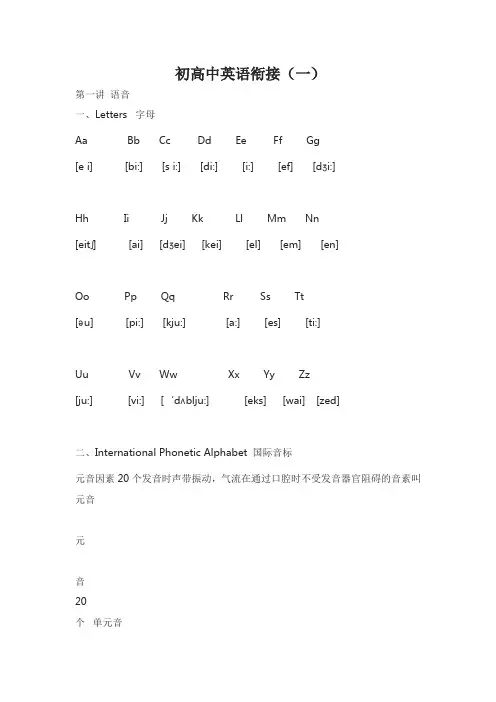
初高中英语衔接(一)第一讲语音一、Letters 字母Aa Bb Cc Dd Ee Ff Gg[e i] [bi:] [s i:] [di:] [i:] [ef] [dʒi:]Hh Ii Jj Kk Ll Mm Nn[eitʃ] [ai] [dʒei] [kei] [el] [em] [en]Oo Pp Qq Rr Ss Tt[əu] [pi:] [kju:] [a:] [es] [ti:]Uu Vv Ww Xx Yy Zz[ju:] [vi:] [‘dʌblju:] [eks] [wai] [zed]二、International Phonetic Alphabet 国际音标元音因素20个发音时声带振动,气流在通过口腔时不受发音器官阻碍的音素叫元音元音20个单元音(12个)前元音:[i:] [ i ] [e ] [æ]中元音:[ ə:] [ ə ] [ ʌ ]后元音:[ a: ] [ ɔ:] [ ɔ ] [u:] [u]双元音(8个) 合口双元音:[ei ] [ ai ] [ ɔi ] [ əu ] [ au ]集中双元音:[ iə ] [εə ] [ uə]辅音因素28个发音时气流在通过口腔时受到发音器官的阻碍而发出的音素叫辅音。
其中声带振动的叫浊辅音,声带不震动的叫清辅音轻辅音/p/ / t/ / k/ /f/ /θ/ /s/浊辅音/b/ /d/ /g/ /v/ /ð/ /z/轻辅音/ts/ /ʃ/ /tʃ/ /tr/ / h/浊辅音/dz/ /ʒ/ /dʒ/ /dr/ /r/鼻音/m/ /n/ /ŋ/半元音/w/ /j/ 舌边音/ǀ/语音的基本常识1、音节的划分一个单词的音标中有几个元音就有几个音节。
2、重读音节任何双音节或多音节单词的音标中,有重读音节和非重读音节,哪一个音节重读,该音节的左上方或该音节的元音上方标有重读符号“'”。
3、浊化音以sp__, st___, sk___开头的单词中,清辅音/p/ /t/ /k/分别要发浊辅音/b/ /d/ /g/。
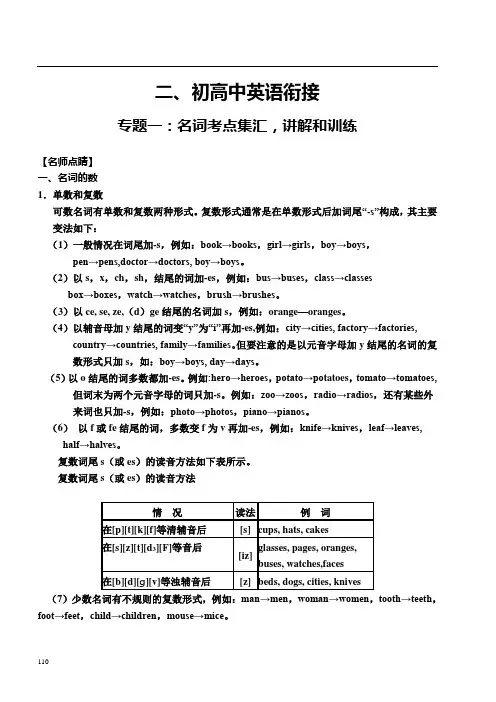
二、初高中英语衔接专题一:名词考点集汇,讲解和训练【名师点睛】一、名词的数1.单数和复数可数名词有单数和复数两种形式。
复数形式通常是在单数形式后加词尾“-s”构成,其主要变法如下:(1)一般情况在词尾加-s,例如:book→books,girl→girls,boy→boys,pen→pens,doctor→doctors, boy→boys。
(2)以s,x,ch,sh,结尾的词加-es,例如:bus→buses,class→classes box→boxes,watch→watc hes,brush→brushes。
(3)以ce, se, ze,(d)ge结尾的名词加s,例如:orange—oranges。
(4)以辅音母加y结尾的词变“y”为“i”再加-es,例如:city→cities, factory→factories, country→countries, family→families。
但要注意的是以元音字母加y结尾的名词的复数形式只加s,如:boy→boys, day→days。
(5)以o结尾的词多数都加-es。
例如:hero→heroes,potato→po tatoes,tomato→tomatoes,但词末为两个元音字母的词只加-s。
例如:zoo→zoos,radio→radios,还有某些外来词也只加-s,例如:photo→photos,piano→pianos。
(6)以f或fe结尾的词,多数变f为v再加-es,例如:knife→knives,leaf→leaves, half→halves。
复数词尾s(或es)的读音方法如下表所示。
复数词尾s(或es)的读音方法(7)少数名词有不规则的复数形式,例如:man→men,woman→women,tooth→teeth,foot→feet,child→children,mouse→mice。
110【注意】与man和woman构成的合成词,其复数形式也是-men和-women。
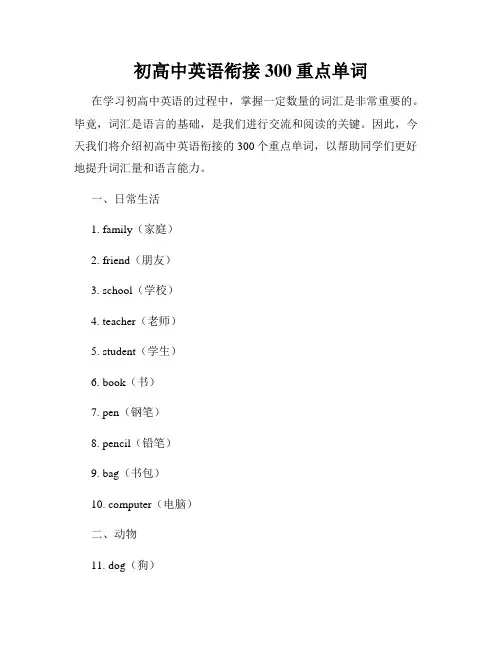
初高中英语衔接300重点单词在学习初高中英语的过程中,掌握一定数量的词汇是非常重要的。
毕竟,词汇是语言的基础,是我们进行交流和阅读的关键。
因此,今天我们将介绍初高中英语衔接的300个重点单词,以帮助同学们更好地提升词汇量和语言能力。
一、日常生活1. family(家庭)2. friend(朋友)3. school(学校)4. teacher(老师)5. student(学生)6. book(书)7. pen(钢笔)8. pencil(铅笔)9. bag(书包)10. computer(电脑)二、动物11. dog(狗)12. cat(猫)13. bird(鸟)14. fish(鱼)15. horse(马)16. rabbit(兔子)17. turtle(乌龟)18. lion(狮子)19. tiger(老虎)20. elephant(大象)三、食物21. apple(苹果)22. banana(香蕉)23. orange(橙子)24. grape(葡萄)25. pizza(比萨)26. hamburger(汉堡)27. rice(米饭)28. noodle(面条)29. bread(面包)30. milk(牛奶)四、学科31. math(数学)32. English(英语)33. science(科学)34. history(历史)35. geography(地理)36. art(美术)37. music(音乐)38. PE(体育)39. chemistry(化学)40. physics(物理)五、颜色41. red(红色)42. blue(蓝色)43. yellow(黄色)44. green(绿色)45. orange(橙色)46. purple(紫色)47. black(黑色)48. white(白色)49. gray(灰色)50. pink(粉色)六、时间51. year(年)52. month(月)53. week(周)54. day(日)55. hour(小时)56. minute(分钟)57. second(秒)58. today(今天)59. tomorrow(明天)60. yesterday(昨天)七、自然界61. sun(太阳)62. moon(月亮)63. star(星星)64. sky(天空)65. cloud(云)66. rain(雨)67. snow(雪)68. wind(风)69. tree(树)70. flower(花)八、身体部位71. head(头)72. face(脸)73. eye(眼睛)74. nose(鼻子)75. mouth(嘴巴)76. ear(耳朵)77. hair(头发)78. hand(手)79. leg(腿)80. foot(脚)九、交通工具81. car(汽车)82. bike(自行车)83. bus(公交车)84. train(火车)85. airplane(飞机)86. boat(船)87. subway(地铁)88. taxi(出租车)89. motorcycle(摩托车)90. helicopter(直升机)十、国家与国籍91. China(中国)92. America(美国)93. England(英国)94. Japan(日本)95. France(法国)96. Germany(德国)97. Australia(澳大利亚)98. Canada(加拿大)99. Brazil(巴西)100. India(印度)十一、职业与工作101. doctor(医生)102. teacher(教师)103. engineer(工程师)104. nurse(护士)105. police officer(警察)106. farmer(农民)107. musician(音乐家)108. actor(演员)109. chef(厨师)110. scientist(科学家)十二、运动与娱乐111. swim(游泳)112. dance(跳舞)113. play basketball(打篮球)114. play football(踢足球)115. run(跑步)116. sing(唱歌)117. draw(绘画)118. watch TV(看电视)119. listen to music(听音乐)120. read books(读书)十三、节假日与庆祝活动121. Spring Festival(春节)122. Christmas(圣诞节)123. New Year's Day(元旦)124. Thanksgiving(感恩节)125. Halloween(万圣节)126. birthday(生日)127. wedding(婚礼)128. graduation(毕业)129. party(派对)130. concert(音乐会)十四、自然现象131. sun(太阳)132. moon(月亮)133. star(星星)134. sky(天空)135. cloud(云)136. rain(雨)137. snow(雪)138. wind(风)139. lightning(闪电)140. thunder(雷)十五、文化与艺术141. painting(绘画)142. sculpture(雕塑)143. literature(文学)144. poetry(诗歌)145. music(音乐)146. dance(舞蹈)147. theater(戏剧)148. film(电影)149. photography(摄影)150. calligraphy(书法)文章至此结束,通过掌握这300个重点单词,同学们可以在初高中英语之间更好地衔接起来。
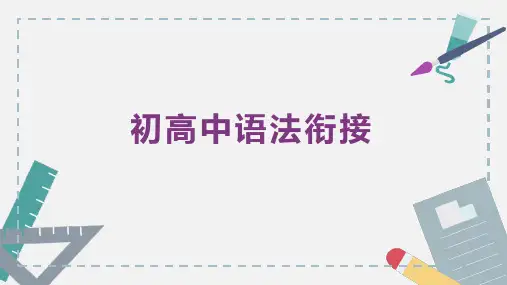
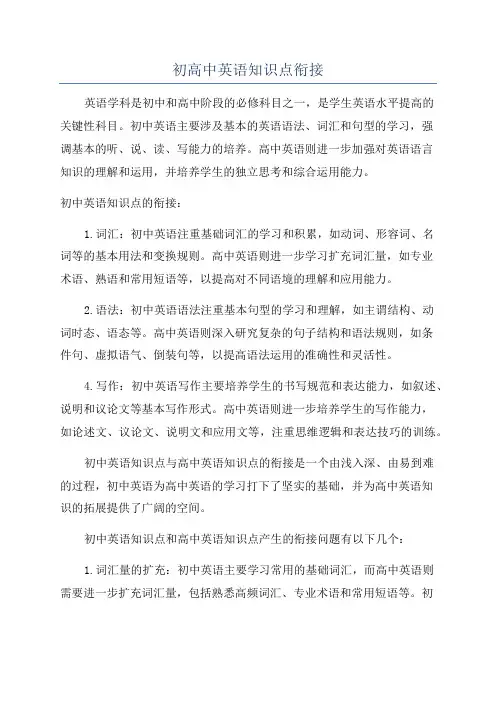
初高中英语知识点衔接英语学科是初中和高中阶段的必修科目之一,是学生英语水平提高的关键性科目。
初中英语主要涉及基本的英语语法、词汇和句型的学习,强调基本的听、说、读、写能力的培养。
高中英语则进一步加强对英语语言知识的理解和运用,并培养学生的独立思考和综合运用能力。
初中英语知识点的衔接:1.词汇:初中英语注重基础词汇的学习和积累,如动词、形容词、名词等的基本用法和变换规则。
高中英语则进一步学习扩充词汇量,如专业术语、熟语和常用短语等,以提高对不同语境的理解和应用能力。
2.语法:初中英语语法注重基本句型的学习和理解,如主谓结构、动词时态、语态等。
高中英语则深入研究复杂的句子结构和语法规则,如条件句、虚拟语气、倒装句等,以提高语法运用的准确性和灵活性。
4.写作:初中英语写作主要培养学生的书写规范和表达能力,如叙述、说明和议论文等基本写作形式。
高中英语则进一步培养学生的写作能力,如论述文、议论文、说明文和应用文等,注重思维逻辑和表达技巧的训练。
初中英语知识点与高中英语知识点的衔接是一个由浅入深、由易到难的过程,初中英语为高中英语的学习打下了坚实的基础,并为高中英语知识的拓展提供了广阔的空间。
初中英语知识点和高中英语知识点产生的衔接问题有以下几个:1.词汇量的扩充:初中英语主要学习常用的基础词汇,而高中英语则需要进一步扩充词汇量,包括熟悉高频词汇、专业术语和常用短语等。
初中阶段的词汇积累为高中英语的学习提供了基础,但在高中阶段仍需要进一步扩充和记忆词汇,以适应更高要求的阅读和写作任务。
2.语法规则的拓展:初中英语主要学习基本的语法规则和句型,如主谓结构、动词时态和语态等。
而高中英语则需要进一步学习复杂的语法规则和句子结构,如条件句、虚拟语气和倒装句等。
初中阶段的语法学习为高中英语的学习提供了基础,但在高中阶段还需要进一步深入学习和理解语法规则,以提高语法运用的准确性和灵活性。
3.阅读理解能力的提升:初中英语注重对短文和文章的基本理解和阅读技巧的培养,如找关键词、推理和判断等。
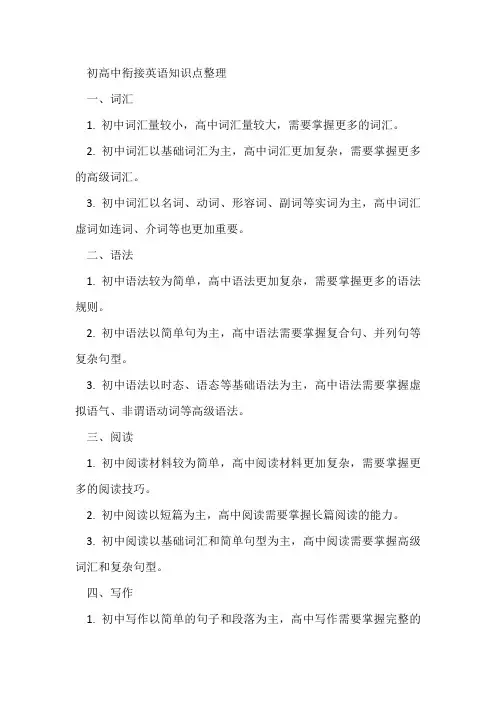
初高中衔接英语知识点整理一、词汇1. 初中词汇量较小,高中词汇量较大,需要掌握更多的词汇。
2. 初中词汇以基础词汇为主,高中词汇更加复杂,需要掌握更多的高级词汇。
3. 初中词汇以名词、动词、形容词、副词等实词为主,高中词汇虚词如连词、介词等也更加重要。
二、语法1. 初中语法较为简单,高中语法更加复杂,需要掌握更多的语法规则。
2. 初中语法以简单句为主,高中语法需要掌握复合句、并列句等复杂句型。
3. 初中语法以时态、语态等基础语法为主,高中语法需要掌握虚拟语气、非谓语动词等高级语法。
三、阅读1. 初中阅读材料较为简单,高中阅读材料更加复杂,需要掌握更多的阅读技巧。
2. 初中阅读以短篇为主,高中阅读需要掌握长篇阅读的能力。
3. 初中阅读以基础词汇和简单句型为主,高中阅读需要掌握高级词汇和复杂句型。
四、写作1. 初中写作以简单的句子和段落为主,高中写作需要掌握完整的文章结构和逻辑。
2. 初中写作以基础词汇和简单句型为主,高中写作需要掌握高级词汇和复杂句型。
3. 初中写作以记叙文为主,高中写作需要掌握议论文、说明文等不同类型的写作技巧。
五、听力1. 初中听力材料较为简单,高中听力材料更加复杂,需要掌握更多的听力技巧。
2. 初中听力以基础词汇和简单句型为主,高中听力需要掌握高级词汇和复杂句型。
3. 初中听力以对话和短文为主,高中听力需要掌握新闻、讲座等不同类型的听力技巧。
六、口语1. 初中口语较为简单,高中口语更加复杂,需要掌握更多的口语技巧。
2. 初中口语以基础词汇和简单句型为主,高中口语需要掌握高级词汇和复杂句型。
3. 初中口语以日常对话为主,高中口语需要掌握演讲、辩论等不同类型的口语技巧。
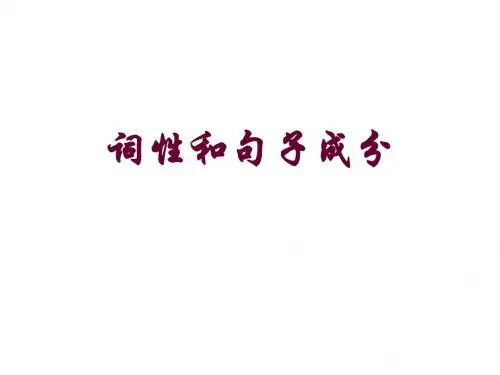
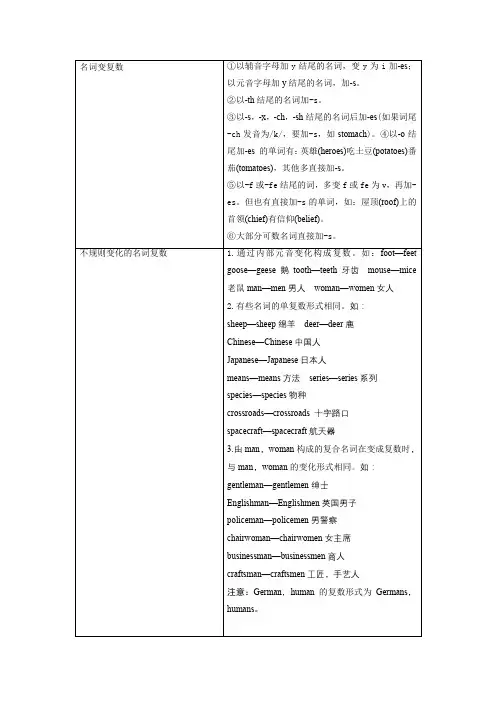
名词变复数①以辅音字母加y结尾的名词,变y为i加-es;以元音字母加y结尾的名词,加-s。
②以-th结尾的名词加-s。
③以-s,-x,-ch,-sh结尾的名词后加-es(如果词尾-ch发音为/k/,要加-s,如stomach)。
④以-o结尾加-es的单词有:英雄(heroes)吃土豆(potatoes)番茄(tomatoes),其他多直接加-s。
⑤以-f或-fe结尾的词,多变f或fe为v,再加-es。
但也有直接加-s的单词,如:屋顶(roof)上的首领(chief)有信仰(belief)。
⑥大部分可数名词直接加-s。
不规则变化的名词复数 1.通过内部元音变化构成复数。
如:foot—feetgoose—geese鹅tooth—teeth牙齿mouse—mice老鼠man—men男人woman—women女人2.有些名词的单复数形式相同。
如:sheep—sheep绵羊deer—deer鹿Chinese—Chinese中国人Japanese—Japanese日本人means—means方法series—series系列species—species物种crossroads—crossroads 十字路口spacecraft—spacecraft航天器3.由man,woman构成的复合名词在变成复数时,与man,woman的变化形式相同。
如:gentleman—gentlemen绅士Englishman—Englishmen英国男子policeman—policemen男警察chairwoman—chairwomen女主席businessman—businessmen商人craftsman—craftsmen工匠,手艺人注意:German,human的复数形式为Germans,humans。
冠词不定冠词 a 、an的基本用法:1. 泛指一个人或某物:He saw a dog.2. 泛指某一类人或物: A horse is a useful animal.3.表示数量“一”(但数的概念没有one强烈):Ibought a book .4.表示首次提到的人或物:Long long ago, there wasa king ....5.用在序数词、形容词比较级、最高级前:a second/third cup of tea (再一;又一)a better life; a most handsome young man6.抽象不可数名词具体化:a big surprise a great successa knowledge of Englisha coffee catch a heavy rain7.用在某些固定词组中:a lot of after a while as a matter of face定冠词the的基本用法1.特指人或物: Show me the photo of the boy.2.谈话双方都知道的人或事物: Open the window,please.3.指上文提到的人或事物: I have a car. The car is red.4. 指世界上独一无二的事物: the sun/the earth5. 序数词, 形容词最高级前: the first lesson, theeasiest way6. 某些形容词前, 表示某一类人: the poor, the blind7. 姓氏复数前,表示“一家人”或“夫妻俩”:the Greens8.方位词前、西洋乐器名称前: on the leftplay the piano9. 普通名词构成的专有名词前,江河湖海山脉群岛及国家和党派团体等名词前: the Great Wall, theYangzi River, the Party10. 逢十的复数名词或年代、朝代前in the fifties,in the 1870’s11. 用在某些固定词组中:by the way, in the openair, in the end代词的单复数单数复数代词的分类第一人称第二人称第三人称第一人称第二人称第三人称人称代词主格I you he she it we you they宾格me you him her it us you them物主代词形容词性my your his her its our your their名词性mine yourshis hersitsours yours theirs反身代词myselfyourself himselfherselfitselfourselves yourselves themselves时态 1. 一般现在时(do/does)常与表示频度的副词如always,usually, often, sometimes, never, every day等连用。
初高中英语衔接词汇初高中英语衔接词汇(1)*注:【】内标注书页为人教版。
1. enjoy 【七下 p.47】英[?n'd] 美[?n'd]vt.享有,享受; 欣赏; 喜欢; 使过得快活;vi.使过得快活;It is very quiet and I enjoy reading there.那里非常安静,我很喜欢在那里阅读。
2. environment英[?n' va?r?nm?nt] 美[?n' va?r?nm?nt, -' va??n-]n. 环境,外界;周围,围绕;工作平台;(运行)环境How is today’s environment changing your customers?今天的环境如何改变你的客户,3. even if英[' i:v?n if] 美[' iv?n ?f]即使,纵然;虽然;即若;哪怕The respect an entrepreneur 's plan , even if it deviates from their own.他们尊重创业者的计划,就算它背离他们自己的计划。
4. event英[?' vent] 美[?' v?nt]n.事件,大事; 活动,经历; 结果; 运动项目;Next day the newspapers reported the event.第二天,报纸报导道了这个事件。
5. ever[英]['ev?(r)] [美][??v?]adv.永远; 曾经,这以前; 究竟,到底; 可能;That's the best movie I've ever seen! 那是我看过的最棒的电影~6. excite[英][?k'sa?t][美][?k?sa?t]vt.使兴奋; 激发; 刺激; 使紧张不安;The good news excited everybody. 这个好消息使每一个人都很兴奋。
初高中英语衔接专题一:名词考点集汇,讲解和训练一、名词的数1.单数和复数可数名词有单数和复数两种形式。
复数形式通常是在单数形式后加词尾“・s”构成, 其主要变法如下:(1)一般情况在词尾加-s,例如:book—books, girl—girls, boy一boys, pen—pens,doctor-doctors, boy—* boys □(2)以s, x, ch, sh,结尾的词加・es,例如:bus—buses, class一classesbox—boxes, watch—watches, brush—brushes。
(3)以ce, se, ze, (d) ge 结尾的名词加s,例如:orange—orangeso(4)以辅音母加y结尾的词变“y”为“i”再加・es,例如:city一cities,factory—"factories, country—countries, familLfamilies。
但要注意的是以元音字母加y结尾的名词的复数形式只加s,如:boy一boys, day—days。
(5)以。
结尾的词多数都加・es。
例如:hero—heroes, potato—potatoes, tomato—tomatoes,但词末为两个元音字母的词只加-s。
例如:zoo—zoos, radio-* radios,还有某些外来词也只加-s,例如:photo—photos, piano-^pianoso(6)以f或fe结尾的词,多数变f为v再加-es,例如:knife—knives,leaf—leaves, half—halves。
复数词尾s (或es)的读音方法如下表所示。
复数词尾S (或es)的读音方法(7)少数名词有不规则的复数形式,例如:man—men, woman—women, tooth—teeth, foot—feet, child-children, mouse-mice。
【注意】与man和woman构成的合成词,其复数形式也是-men和-womeno 例如:an Englishman, two Englishmeno但German不是合成词,故复数形式为Germans;man, woman等作定语时,它的单复数以其所修饰的名词的单复数而定, 如:men workers, women teachers□有个别名词单复数一样,例如:Chinese, Japanese, sheep, deer, fish等。
但当fish 表示不同种类的鱼时,可以加复数词尾。
(8)单数形式但其意为复数的名词有:people, police等。
(9)数词+名词作定语时,这个名词一般保留单数形式,中间加连字符。
例如an8-year-old girl, a ten-mile walko(10)还有些名词仅有复数形式,如:trousers, clothes, chopsticks, glasses, goods,ashes, scissors, compasseso(11)只用作单数的复数形式的名词有:科学名词:physics, mathematics/maths游戏名称:bowls专有名词:the United States, Niagara Falls其他名词:news, falls2,不可数名词“量”的表示方法在英语中,不可数名词如果要表示“量的概念”,可以用以下两种方法:(1)用much, a little, a lot of/lots of, some, any 等表示多少,例如:The rich man has a lot of money.There is some milk in the bottle.Is there any water in the glass?I don't like winter because theres too much snow and ice.(2)用a piece of这类定语,例如:a piece of paper a piece of wood a piece of breada bottle of orange a glass of water (milk) a cup of teaa cup of tea a bag of rice three bags of rice如果要表示“两杯茶”、“四张纸”这类概念时,在容器后加复数,例如:two cups of teafour pieces of paperthree glasses of water不可数名词也可用a lot of, lots of, some, any, much等来修饰。
二、名词的所有格名词所有格,用来表示人或物的所有,以及领属关系。
1.表示有生命的名词的所有格其单数形式是加’s,其复数形式是s',例如:a students room, students rooms, fathers shoeso2.如其结尾不是s的复数形式仍加’s,如:Children's Day<>3.在表示时间、距离、长度、重量、价格、世界、国家等名词的所有格要用’s,例如:a twenty minutes1 walk, ten miles' journey, a boats length, two pounds' weight, ten dollars1 worth o4.无生命名词的所有格则必须用of结构,例如:a map of China, the end of this term, the capital of our country, the color of the flowerso5.双重所有格,例如:a friend of my father'so【注意】如果两个名词并列,并且分别有’s,则表示“分别有”,例如:John's and Mary's rooms (约翰和玛丽各有一间,共两间);Tom's and Mary's bikes (两人各自的自行车)。
两个名词并列,只有一个's,则表示"共有",例如:John and Mary's room (约翰和玛丽共有一间);Tom and Mary's mother (即Tom与Mary是兄妹)。
【演练】1.・・• Where have you been, Tim?…I've been to.A・ the Henry house B. the Henry familyC. The Henry's homeD. Henry's2.In England, if is in the middle of the day, the evening meal is calledsupper.A. foodB. lunchC. breakfastD. dinner3.You looked for it twice, but you haven't found it. Why not try.A. three timesB. a third timeC. the third timeD. once4.・.. They are thirsty. Will you please give them …Certainly.A. some bottles of watersB. some bottles of waterC. some bottle of waterD. some bottle of waters5.Mike hurt one of his in the accident yesterday.A. toothB. feetC. handD. ear6.There is some on the plate.A. cakesB. meatC. potatoD. pears7.In England, the last name is the .A. family nameB. middleC. given nameD. full name8.They are going to fly to Beijing.A. GermenB. GermanyC. GermanysD. Germans9.The has two•A・ boys; watches B. boy; watch C. boy; watches D. boys; watch10.The little baby has two already.A. toothB. toothsC. teethD. teeths11.What's your for being late again?A・ idea B. key C. excuse D. news12.-- It's dangerous here. We'd better go out quickly.・・・ But I think we should let go out first.A. woman and childrenB. women and childC・ woman and child D. women and children13.・・■ You can see Mr.Smith if there is a sign "”on the door of his shop.・・・Thanks.A.ENTRANCEB.BUSINESS HOURSC.THIS SIDE UPD.NO SMOKING14.Are they going to have a picnic on?A. Children's DayB. Childrens's DayC. Childrens DayD. Children Day15.Where are the students? Are they in?6. B7.A8.D9.C 10.C 11.C 12.D 13.B 14.A 15.B专题二:形容词、副词考点集汇,讲解和训练【名师点睛】1. 形容词的用法(1) 形容词在句中作定语,表语,宾语补足语。
例如:Our country is a beautiful country.(作定语) The fish went bad.(作表语)We keep our classroom clean and tidy.(作宾语补足语)(2) 形容词修饰something, anything, nothing, everything 等不定代词时,形容 词放在名词后面。